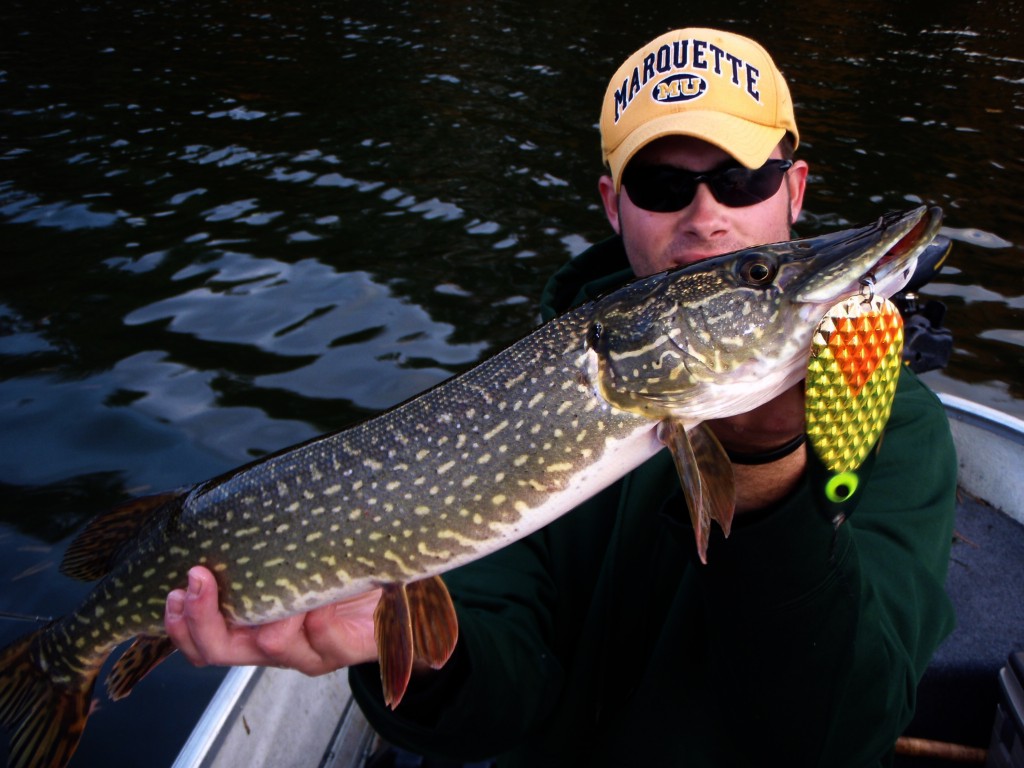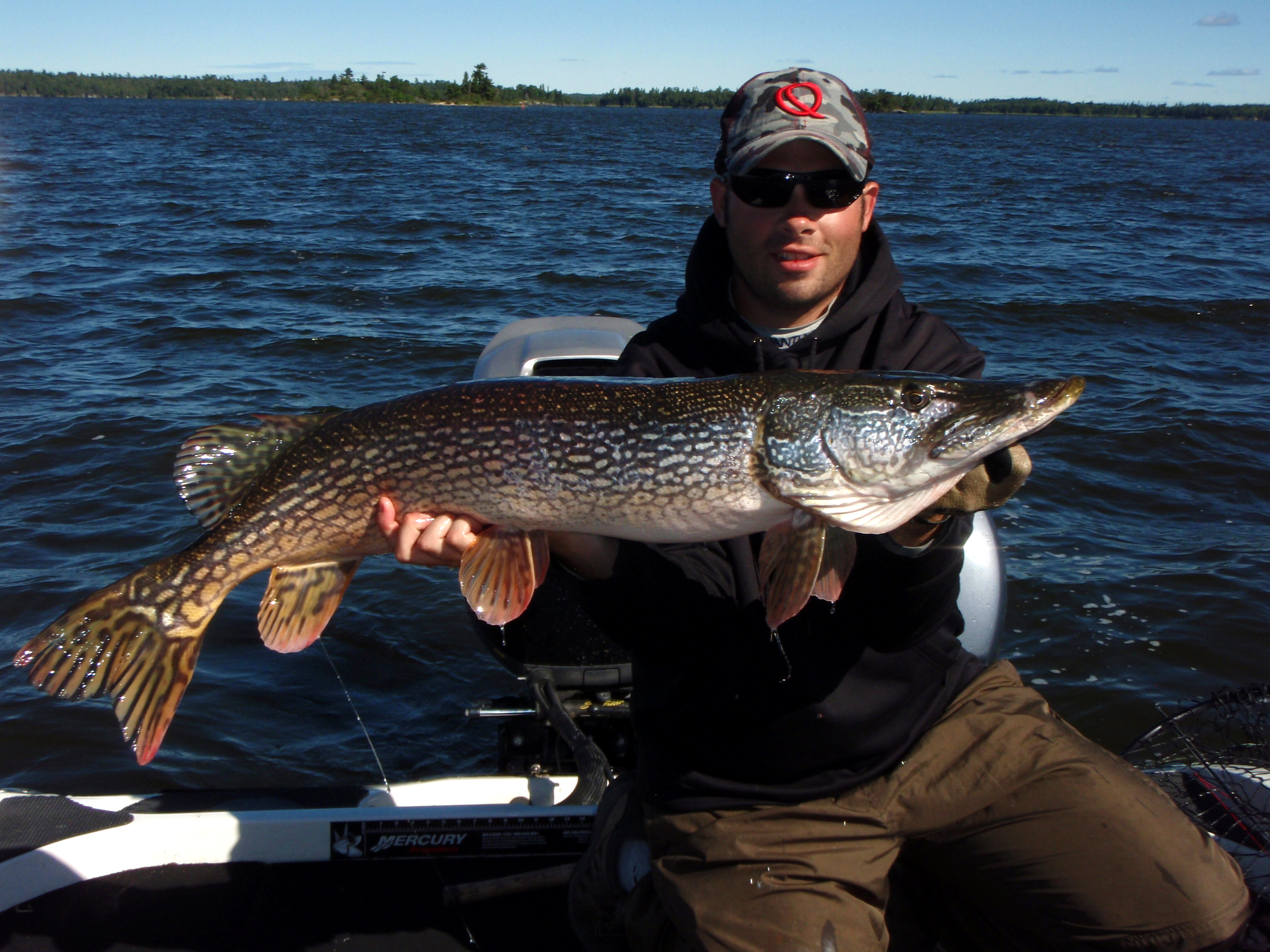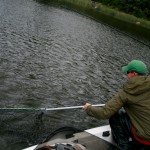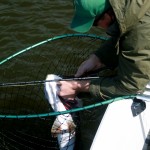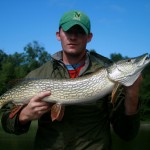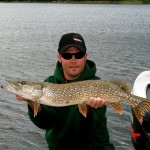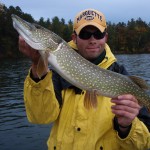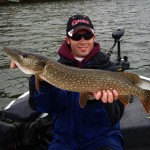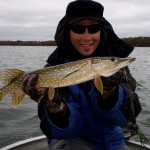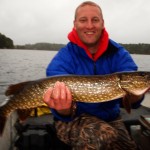Anglers can catch big fish on any cast during any portion of the season. As it happens with every species of fish, the odds obviously rise during specific times and conditions.
During end of summer and early fall, northern pike experience a gathering of teeth. This gathering is a congregation of actively feeding fish that are influenced by coldfronts, wind, low pressure, lowlight conditions and cooling water temperatures. The environment during this period of seasonal change, from summer peak to early fall, brings pike together for one single purpose; to feed heavily.
As it occurs during every warm water season, the largest and most desirable northern pike in every system are restricted to habitats offering the most suitable thermal conditions. Nearly everywhere I fish throughout the north, most of the larger northern pike will be found relating to open water: Deep basins and cooler areas of the main lake where they roam and suspend above the thermocline and off the edges of deeper reefs, points, and weedlines. While these types of locations can lead to difficult but not impossible fishing conditions, waiting for the calendar to turn and weather to change for the worst can dramatically improve the fishing.
At some point, depending on geographical region and where you primarily fish, the late summer season begins its slow day-by-day transition into the fall. Along the way will come successive low pressure systems, coldfronts, and colder nights. As the weather gradually turns from warm to cool, a steady drop in water temperature follows suit. Because of cooling water, vulnerable forage – and free reign of migrations from deep main lake basins to the feeding flats of autumn – northern pike are in their healthiest form and motivated to feed.
This period of change is undoubtedly my favorite time of year for catching incredible numbers of northern pike. It also happens to be the best time of year for catching the largest specimens. In the north, this pike feeding phenomenon comes into play during late summer and lasts throughout September and October.
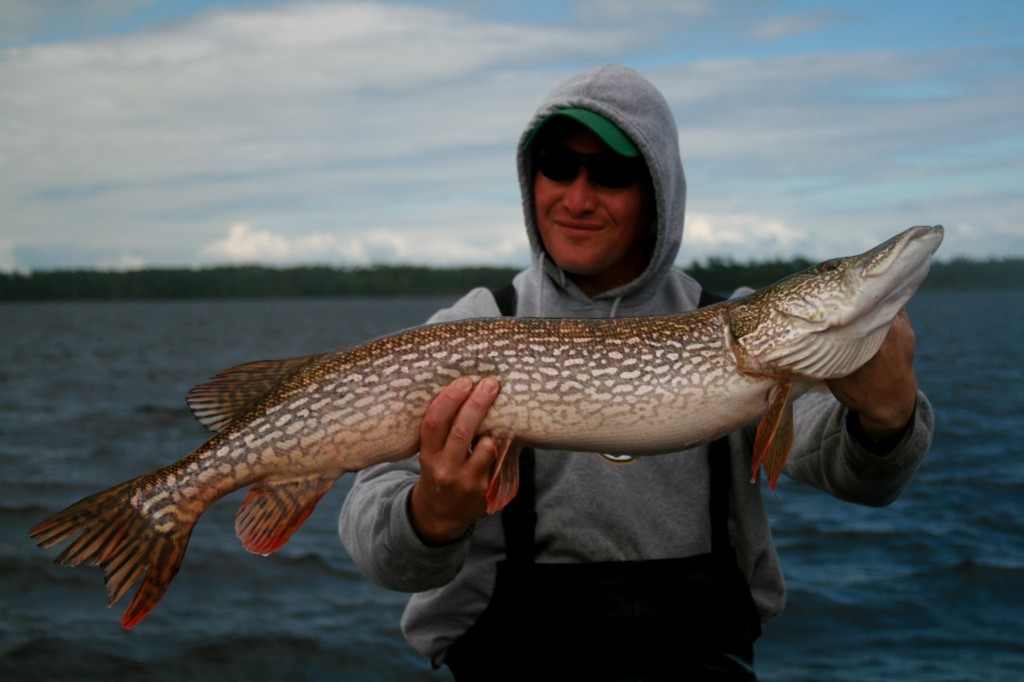
Cooling Water Temperatures
All species of fish are affected by weather changes. Depending on the combination of conditions, these changes can cause fish to feed more aggressively or make fishing difficult. In the hunt for esox lucius, forecasting their feeding isn’t a science, but weather and water temperature greatly influences their feeding habits and helps you determine what lures to fish with.
I’m not a certified meteorologist, but I am a believer that low pressure systems and coldfronts are a northern pike’s greatest ally. These two weather patterns ignite the fishes feeding response, and the alterations in pressure play positive roles in how good the fishing can be. While other species retreat and become dormant during these weather patterns, pike come to life and assume the role of top predator.
Steep pressure drops with overcast skies are the best and often coincide with feeding sprees. Additionally, post-frontal conditions that result in significantly dropping water temperatures also trigger the same. Wind from the north is beneficial too, especially long-term periods as it drives pike shallow, creating ideal light and temperature conditions. Hungry wolf packs of Northern pike will travel from deep open water main lake basins into the shallows for a furious midday binge.
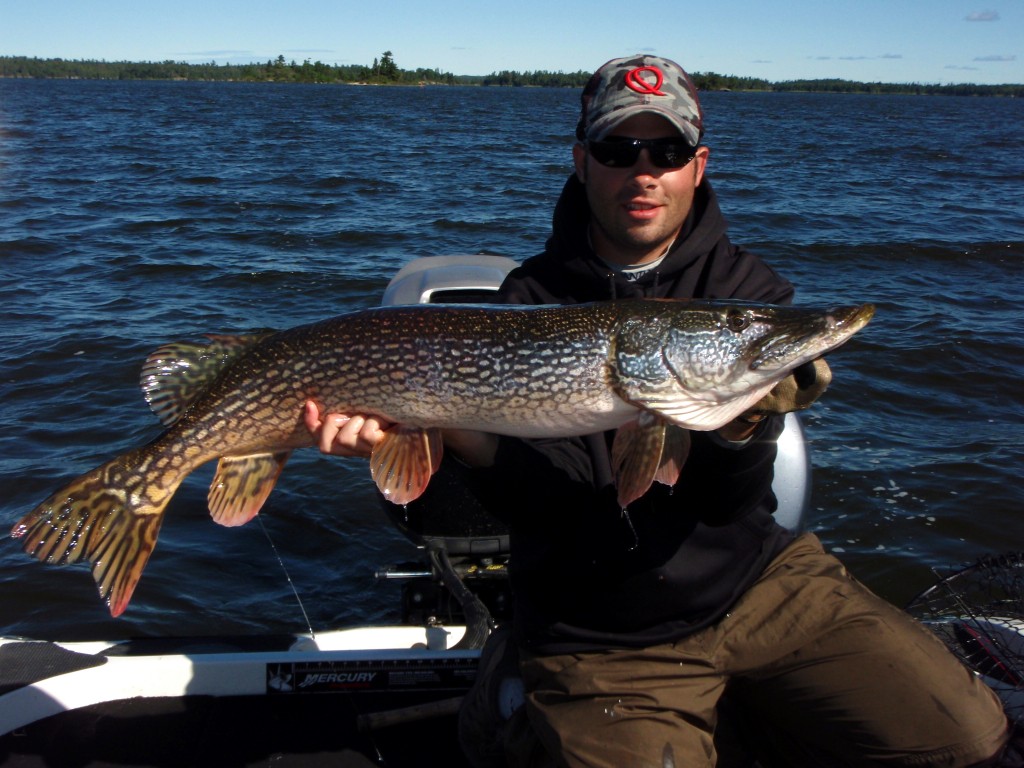
LATE SUMMER – The dog days of summer in August have to end at some point, right? 2012 was one of the hottest summers on record in the Upper Midwest. It officially ended for me during the second week of August 2012. This period of change was observed on the northwest angle of Lake of the Woods. During three days of high pressure prior to the two day low pressure system we dealt with, water temperatures were 72-74 degrees (summer peak) and muskies were active in the shallows. When a massive low pressure system arrived and brought its accompanying coldfront, wind, and post frontal conditions, water temperatures drastically fell to 64 degrees in less than 36 hours. As expected, muskies became dormant and went into temporary hibernation. During this process, northern pike grew increasingly active. An environmental role change took place as the muskies we were locating on the shallow rock reefs and in cabbage beds were forced out by massive numbers of violently feeding northern pike.
EARLY FALL – Meanwhile, early fall is prime time for amazing pike activity levels too. Depending on your geographic location, late September through mid October can be just as good, if not better for fast and furious action. There is something to be said about layering up and withstanding the elements on the coldest, most miserable days possible. I’ve had my best ever pike fishing on the cloudiest, windiest, and rainiest autumn days in Northern Wisconsin. At this time of the year, fishing isn’t for everyone or the ill-prepared. But the colder the day, the better the fishing will be. The waters of Northern Wisconsin aren’t managed for pike, but some big fish do exist if you know where to look on the lakes still containing adequate pike fisheries that don’t compete with muskies. Typically, one can expect to catch a load of aggressive 30 inchers and an occasional trophy during these miserable angling days by focusing on weeds and their deeper edges.
I am so convinced by miserable weather that unless I have a commitment to go fishing, I will never fish for pike under bluebird skies or warm summertime periods. It’s been well documented that pike feed more actively on cloudy, overcast days than on bright sunny ones. Since that’s the case, why waste the time when I can easily fish for something else? In recent years, I’ve witnessed that weather and water conditions play a more significant role than presentation in determining pike activity and location. Weather and conditions that are otherwise miserable to most other anglers and species of fish affects pike in a positive way.
Locations
Changes in pike location can offer many potential patterns for good fishing. One of the most common environmental transitions is larger pike returning to littoral zones (shallow water areas) to take advantage of the abundant forage. Pike will remain in these areas through fall until the green weeds die off and disappear. Following, they will eventually return to main lake areas to roam during the coldwater period.
Weed patterns, which I tend to fish most, are a classic late summer and early fall pattern in mid- to late-mesotrophic and early-stage eutrophic lakes. When pike move in shallow to feed, some of the best areas I look for are large, weedy, main lake flats and rock points.
On shield lakes such as Lake of the Woods and most glacial lakes I fish in Northern Wisconsin, the primary forage that will be buried in the weeds and seeking refuge during these adverse conditions are yellow perch, shiners, juvenile walleyes and suckers. Green cabbage such as pondweed and brown broadleaf cabbage is ideal for predator and prey. This situation develops when water temperatures drop into the low 60 degree range and will be in effect until temperatures fall into the high 40’s.
This type of environmental transition of fish moving from deep to shallow is exactly what took place for us during that 2012 Lake of the Woods trip. Due to the overabundance of pike in the shallows, we temporarily gave up musky fishing and focused on large pike in the expansive, shallow weedy flats located near deepwater basins. In only a few short hours of fishing one large weedbed, the greatest feeding frenzy of northern pike I had ever experienced in my life took place. My partner Brian Malack nor I remember our exact totals from that day, but a substantial number of 30 to 44 inch fish were caught (sometimes on every cast!) fishing with 6 inch cranes and grandmas. Along with the ones that were caught and released, a couple heartbreaking 45” aerial jumpers were lost too. It was typical Canadian fishing at its finest for those few hours, and a phenomenon I will remember forever.
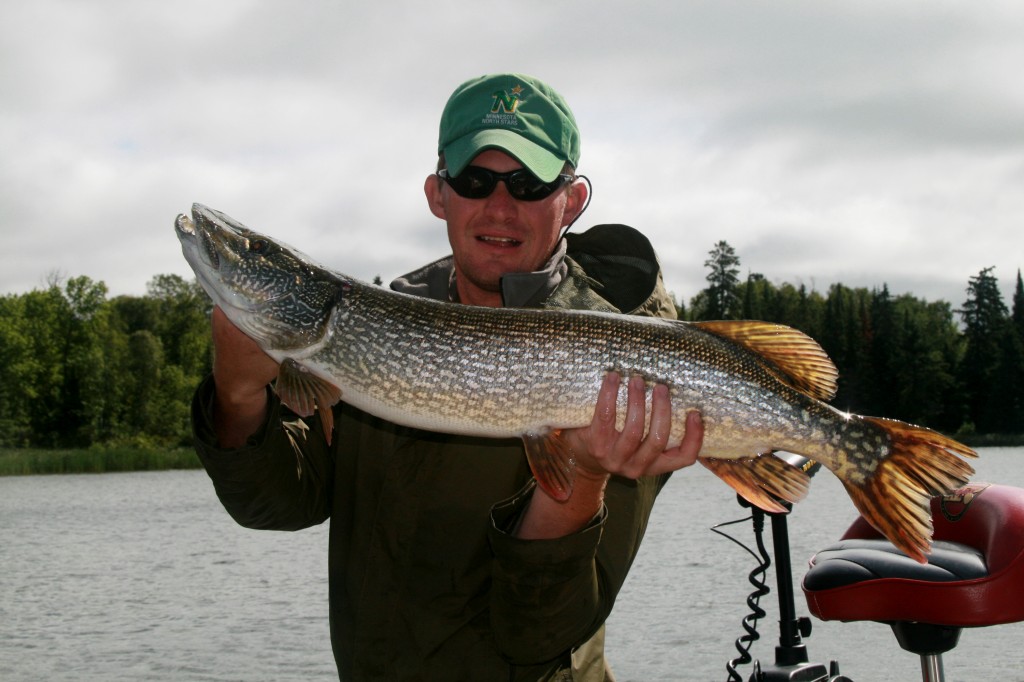
Presentations – The Triggering Effect
In lakes with a traditional weed pattern, I find that sunny, high pressure conditions make for difficult fishing, pushing inactive pike deep into the vegetation. But on a great day with overcast skies and wind, active fish will roam the weedlines in the 8 to 15 foot levels and travel deep into the shallow water bays – sometimes going as shallow as 2 feet. It is important to not only fish the shallow vegetation, but to also make casts into the open water behind you. In these bays, the largest fish are moving, searching, and feeding. Occasionally casting out into the middle of nowhere often catch the largest fish prowling open water.
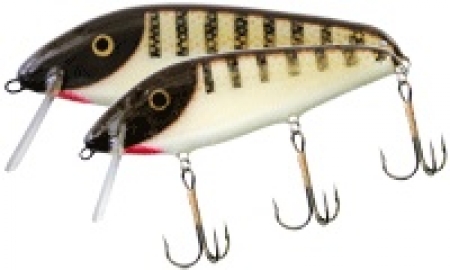 For this type of fishing, I use 7 1/2 foot medium heavy fast action casting rods with 50 and 65 pound Cortland Masterbraid. My favorites are fishing with 6 inch jerkbaits and twitch baits. If I know there are giants roaming in the vicinity, I’ll go as large as something measuring 8 inches or more. The crane bait (205 and 206 model) is a classic balsa minnowbait that runs down to 5 feet with a quick rise. It is deadly for pike when twitched and ripped over the shallow weeds, and often elicits strikes during the pause. However, before fishing with it always replace the stock hooks with Mustad 2X or something of similar strength and sharpness.
For this type of fishing, I use 7 1/2 foot medium heavy fast action casting rods with 50 and 65 pound Cortland Masterbraid. My favorites are fishing with 6 inch jerkbaits and twitch baits. If I know there are giants roaming in the vicinity, I’ll go as large as something measuring 8 inches or more. The crane bait (205 and 206 model) is a classic balsa minnowbait that runs down to 5 feet with a quick rise. It is deadly for pike when twitched and ripped over the shallow weeds, and often elicits strikes during the pause. However, before fishing with it always replace the stock hooks with Mustad 2X or something of similar strength and sharpness.
 Another bait with similar properties is a Grandma lure, a 6 inch model. Fished the same way as you would with a crane, it is a tremendous fish catcher. Color patterns resembling yellow perch and sucker fare best. It’s also worthwhile to experiment with gaudy colors such as firetigers, clowns, and fluorescents as it can pay dividends on conditioned fish, or if a simple change is needed. Also, because pike are cannibalistic, trying pike imitators will work too.
Another bait with similar properties is a Grandma lure, a 6 inch model. Fished the same way as you would with a crane, it is a tremendous fish catcher. Color patterns resembling yellow perch and sucker fare best. It’s also worthwhile to experiment with gaudy colors such as firetigers, clowns, and fluorescents as it can pay dividends on conditioned fish, or if a simple change is needed. Also, because pike are cannibalistic, trying pike imitators will work too.
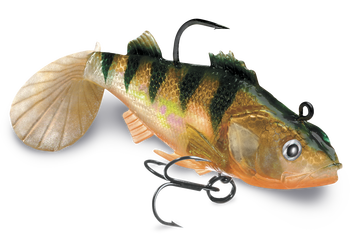
If fishing deeper, such as the nearby deeper basin or sparse vegetation outside of weedlines, glidebaits, divers, and swimbaits are tough to beat. A handful of soft swimbaits such as Storm WildEye Perch and Shads in 4 and 5 inch models often produce outrageous numbers of fish, and sometimes catch the big ones when downsizing is needed. Additionally, medium divers such as the jointed magnum X-Rap and Savage Gear 4-play produce wobble and vibration, and entice bites with a straight power cranking retrieve during windy conditions and lowlight hours. Meanwhile, gliders such as 6 inch Softail Phantoms and Savage Gear Deviator and Freestyler should not be overlooked either.
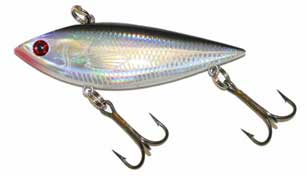 Finally, during the coldest, windiest, most miserable days that can be fished, I’ve done my best with loud rattlebaits. A large Rattlin Rapala or Clackin Rap works well, but bombing long casts with a loud 1.5 oz. Windel’s Rattle Snack wakes them up. Rip it through the weeds or swim it across the basin, it generates vicious reactionary strikes from any opportunistic feeder.
Finally, during the coldest, windiest, most miserable days that can be fished, I’ve done my best with loud rattlebaits. A large Rattlin Rapala or Clackin Rap works well, but bombing long casts with a loud 1.5 oz. Windel’s Rattle Snack wakes them up. Rip it through the weeds or swim it across the basin, it generates vicious reactionary strikes from any opportunistic feeder.
Besides the traditional weedline coverage, I also like to go deep into the jungle. As conditions grow worse such as coldfronts and windy days, I go shallow, often times to as shallow as two feet. Also, as the season progresses deeper into the fall, I will keep going shallower until the weeds fully decay, forcing pike to retreat towards their wintering areas. These shallower feeding zones fish best in lowlight and wind. Oftentimes, I fish the shallows with weedless jigs and oversized trailers that allow for a swimming presentation. Some of my recent favorites, new for 2013, are the Hydra and Stealth jigs from Freedom Tackle Corporation. Both are based on hydrodynamic head designs, and are weedless, minnow styled jigs that feature interchangeable hook designs – meaning they can be fished with any brand and size hook. Available in ½, ¾ and 1 oz models, they fish best with swimbait trailers such as the new Swankz and Swimz from Stankx Bait Company, including my favorite Thug Grubz.
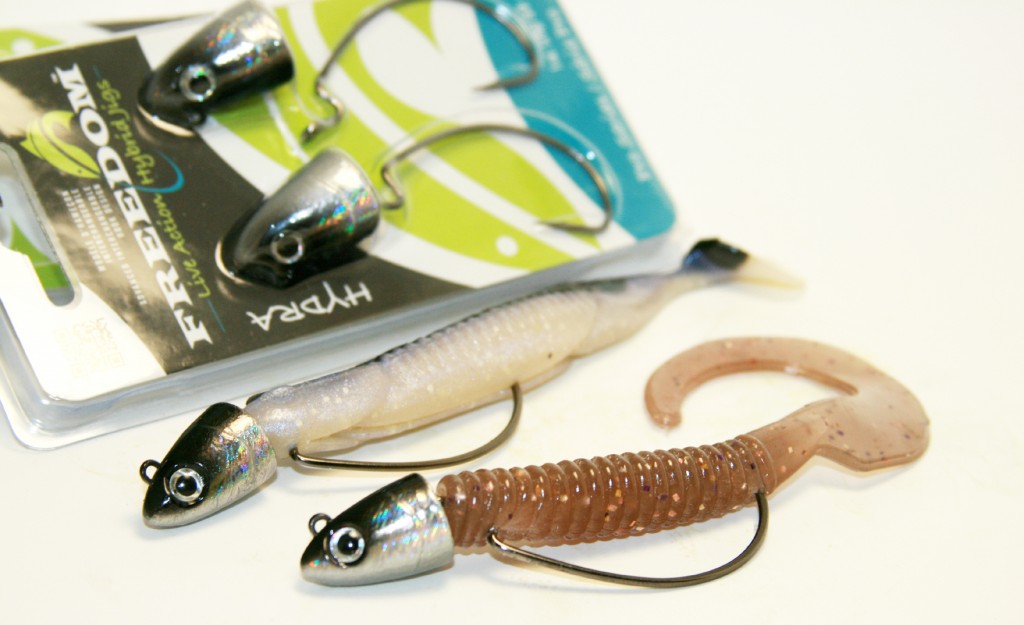
Additionally, oversized spinnerbaits with magnum Colorado blades, and inline spinners and bucktails can work as well. But in my opinion they are better reserved for spring and early summer as pike are primarily focusing on preyfish and baitfish during this summer to fall transitional period.
Expect Numbers and Big Fish
Wind, rain, low pressure systems, coldfronts and post-frontal conditions: Making the trek across the lake in these adverse conditions is not enjoyable or comfortable for the average angler. But once feeding pike move in and have feeding sprees on their minds, the fishing is fun. Pike, in general, are aggressive feeders, and can be caught at anytime. However, certain times are better. The worst weather days of fishing are usually the best for numbers and sizes of big northern pike.
